Evaluation in Leadership Development and Management: A HRM Report
VerifiedAdded on 2020/03/04
|17
|4983
|121
Report
AI Summary
This report provides a comprehensive overview of human resource management, focusing on leadership development, training evaluation, and management development. It emphasizes the significance of leadership in organizational success, highlighting the benefits of leadership training such as increased productivity, employee retention, and engagement. The report discusses the importance of evaluation in performance management and strategic human resource management, detailing various evaluation methods and their roles in assessing the effectiveness of training programs. It also explores leadership development theories, including trait, contingency, behavioral, and full-range theories, underscoring the role of evaluation in identifying and addressing leadership weaknesses. Furthermore, the report examines management development, emphasizing techniques beyond classroom training, such as skill-developing tasks and mentoring. The report highlights the critical role of middle-level managers in communicating organizational goals and vision. In essence, the report underscores the importance of continuous evaluation and development in achieving organizational objectives and fostering effective leadership.
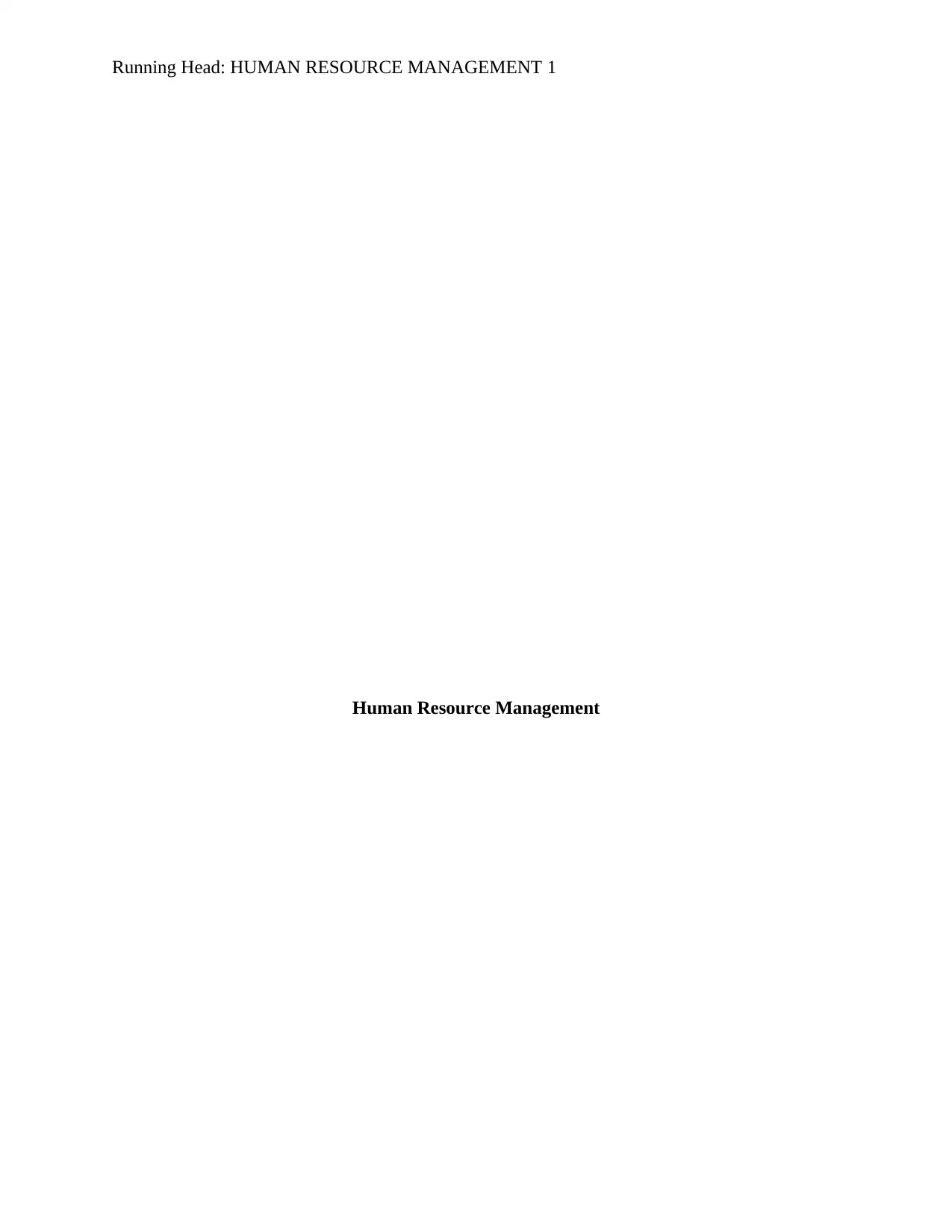
Running Head: HUMAN RESOURCE MANAGEMENT 1
Human Resource Management
Human Resource Management
Paraphrase This Document
Need a fresh take? Get an instant paraphrase of this document with our AI Paraphraser
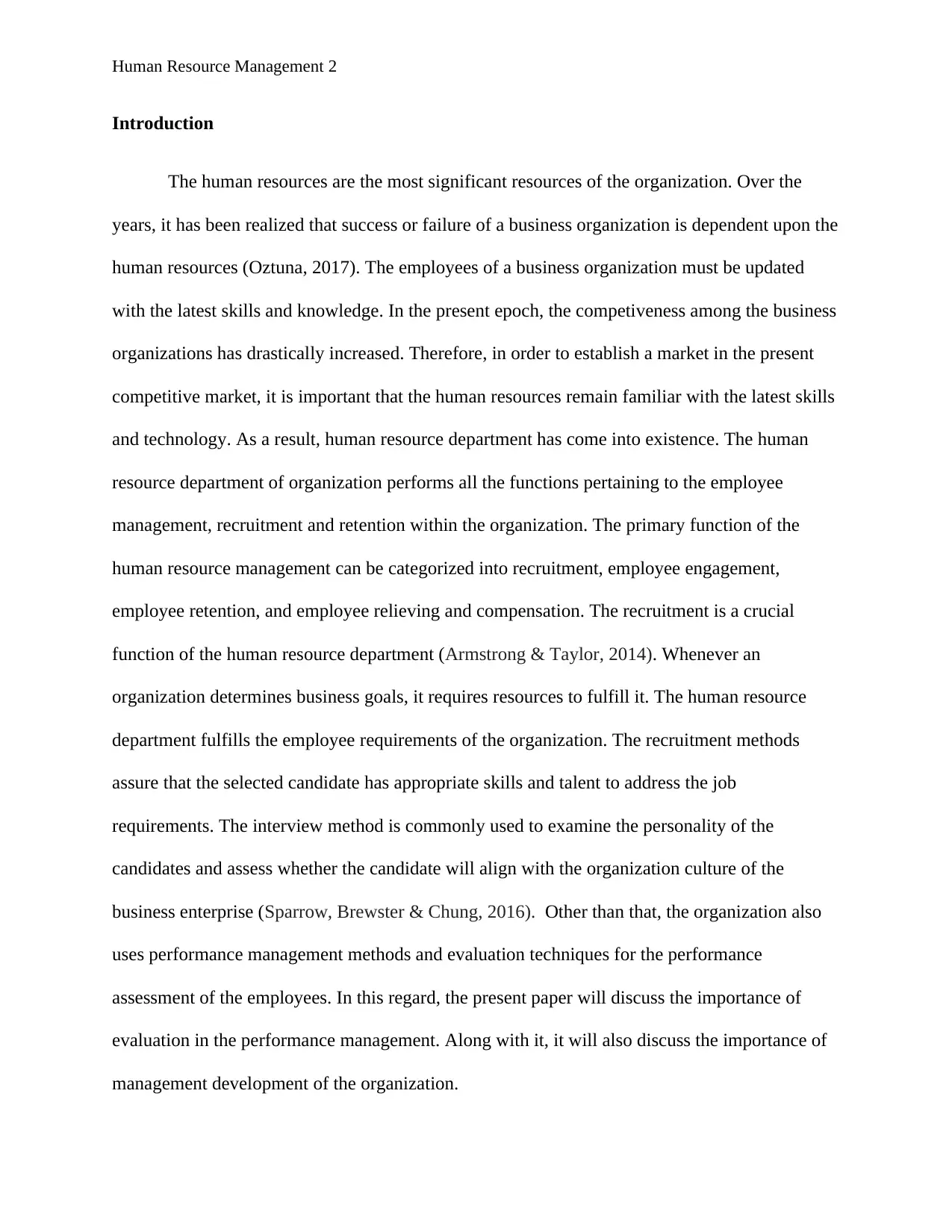
Human Resource Management 2
Introduction
The human resources are the most significant resources of the organization. Over the
years, it has been realized that success or failure of a business organization is dependent upon the
human resources (Oztuna, 2017). The employees of a business organization must be updated
with the latest skills and knowledge. In the present epoch, the competiveness among the business
organizations has drastically increased. Therefore, in order to establish a market in the present
competitive market, it is important that the human resources remain familiar with the latest skills
and technology. As a result, human resource department has come into existence. The human
resource department of organization performs all the functions pertaining to the employee
management, recruitment and retention within the organization. The primary function of the
human resource management can be categorized into recruitment, employee engagement,
employee retention, and employee relieving and compensation. The recruitment is a crucial
function of the human resource department (Armstrong & Taylor, 2014). Whenever an
organization determines business goals, it requires resources to fulfill it. The human resource
department fulfills the employee requirements of the organization. The recruitment methods
assure that the selected candidate has appropriate skills and talent to address the job
requirements. The interview method is commonly used to examine the personality of the
candidates and assess whether the candidate will align with the organization culture of the
business enterprise (Sparrow, Brewster & Chung, 2016). Other than that, the organization also
uses performance management methods and evaluation techniques for the performance
assessment of the employees. In this regard, the present paper will discuss the importance of
evaluation in the performance management. Along with it, it will also discuss the importance of
management development of the organization.
Introduction
The human resources are the most significant resources of the organization. Over the
years, it has been realized that success or failure of a business organization is dependent upon the
human resources (Oztuna, 2017). The employees of a business organization must be updated
with the latest skills and knowledge. In the present epoch, the competiveness among the business
organizations has drastically increased. Therefore, in order to establish a market in the present
competitive market, it is important that the human resources remain familiar with the latest skills
and technology. As a result, human resource department has come into existence. The human
resource department of organization performs all the functions pertaining to the employee
management, recruitment and retention within the organization. The primary function of the
human resource management can be categorized into recruitment, employee engagement,
employee retention, and employee relieving and compensation. The recruitment is a crucial
function of the human resource department (Armstrong & Taylor, 2014). Whenever an
organization determines business goals, it requires resources to fulfill it. The human resource
department fulfills the employee requirements of the organization. The recruitment methods
assure that the selected candidate has appropriate skills and talent to address the job
requirements. The interview method is commonly used to examine the personality of the
candidates and assess whether the candidate will align with the organization culture of the
business enterprise (Sparrow, Brewster & Chung, 2016). Other than that, the organization also
uses performance management methods and evaluation techniques for the performance
assessment of the employees. In this regard, the present paper will discuss the importance of
evaluation in the performance management. Along with it, it will also discuss the importance of
management development of the organization.
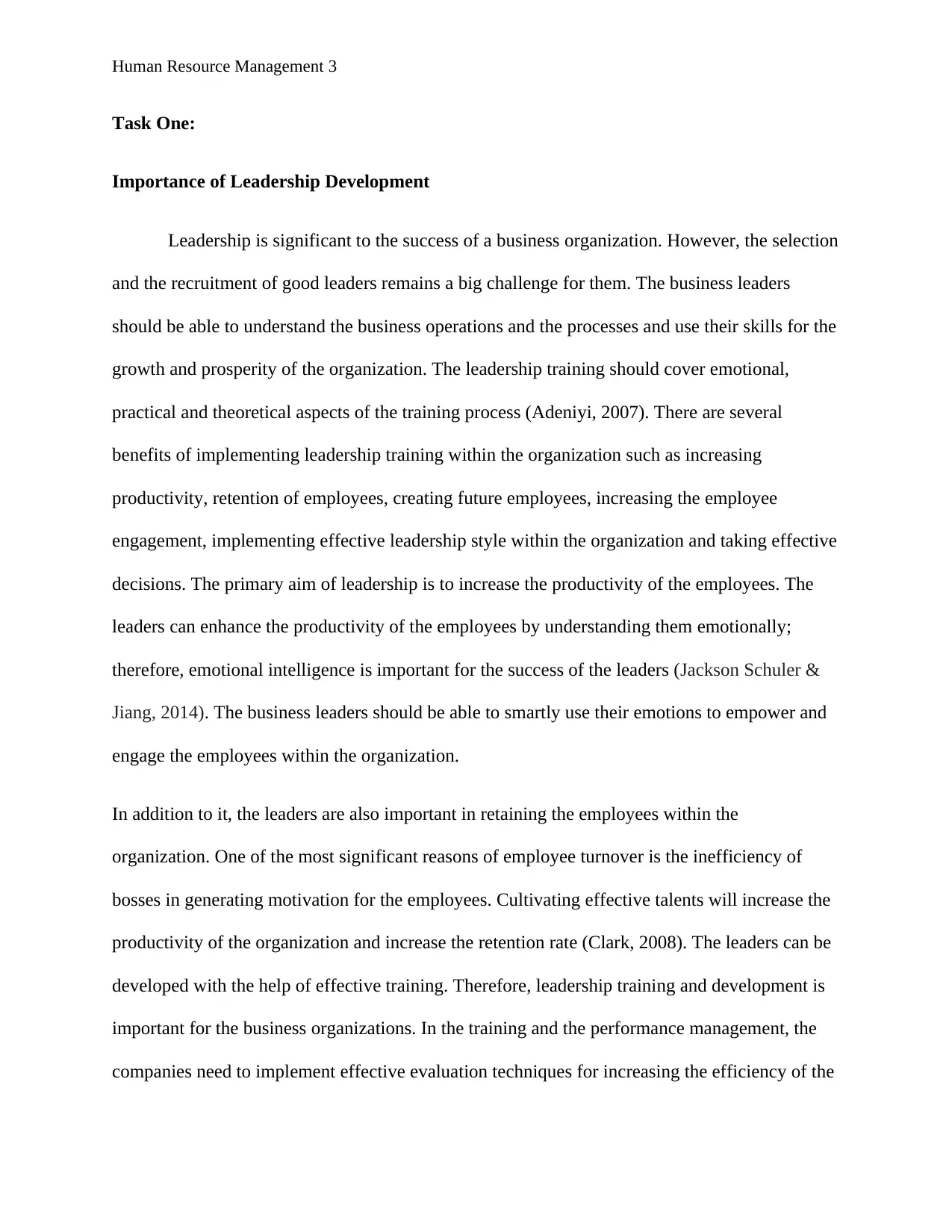
Human Resource Management 3
Task One:
Importance of Leadership Development
Leadership is significant to the success of a business organization. However, the selection
and the recruitment of good leaders remains a big challenge for them. The business leaders
should be able to understand the business operations and the processes and use their skills for the
growth and prosperity of the organization. The leadership training should cover emotional,
practical and theoretical aspects of the training process (Adeniyi, 2007). There are several
benefits of implementing leadership training within the organization such as increasing
productivity, retention of employees, creating future employees, increasing the employee
engagement, implementing effective leadership style within the organization and taking effective
decisions. The primary aim of leadership is to increase the productivity of the employees. The
leaders can enhance the productivity of the employees by understanding them emotionally;
therefore, emotional intelligence is important for the success of the leaders (Jackson Schuler &
Jiang, 2014). The business leaders should be able to smartly use their emotions to empower and
engage the employees within the organization.
In addition to it, the leaders are also important in retaining the employees within the
organization. One of the most significant reasons of employee turnover is the inefficiency of
bosses in generating motivation for the employees. Cultivating effective talents will increase the
productivity of the organization and increase the retention rate (Clark, 2008). The leaders can be
developed with the help of effective training. Therefore, leadership training and development is
important for the business organizations. In the training and the performance management, the
companies need to implement effective evaluation techniques for increasing the efficiency of the
Task One:
Importance of Leadership Development
Leadership is significant to the success of a business organization. However, the selection
and the recruitment of good leaders remains a big challenge for them. The business leaders
should be able to understand the business operations and the processes and use their skills for the
growth and prosperity of the organization. The leadership training should cover emotional,
practical and theoretical aspects of the training process (Adeniyi, 2007). There are several
benefits of implementing leadership training within the organization such as increasing
productivity, retention of employees, creating future employees, increasing the employee
engagement, implementing effective leadership style within the organization and taking effective
decisions. The primary aim of leadership is to increase the productivity of the employees. The
leaders can enhance the productivity of the employees by understanding them emotionally;
therefore, emotional intelligence is important for the success of the leaders (Jackson Schuler &
Jiang, 2014). The business leaders should be able to smartly use their emotions to empower and
engage the employees within the organization.
In addition to it, the leaders are also important in retaining the employees within the
organization. One of the most significant reasons of employee turnover is the inefficiency of
bosses in generating motivation for the employees. Cultivating effective talents will increase the
productivity of the organization and increase the retention rate (Clark, 2008). The leaders can be
developed with the help of effective training. Therefore, leadership training and development is
important for the business organizations. In the training and the performance management, the
companies need to implement effective evaluation techniques for increasing the efficiency of the
⊘ This is a preview!⊘
Do you want full access?
Subscribe today to unlock all pages.

Trusted by 1+ million students worldwide
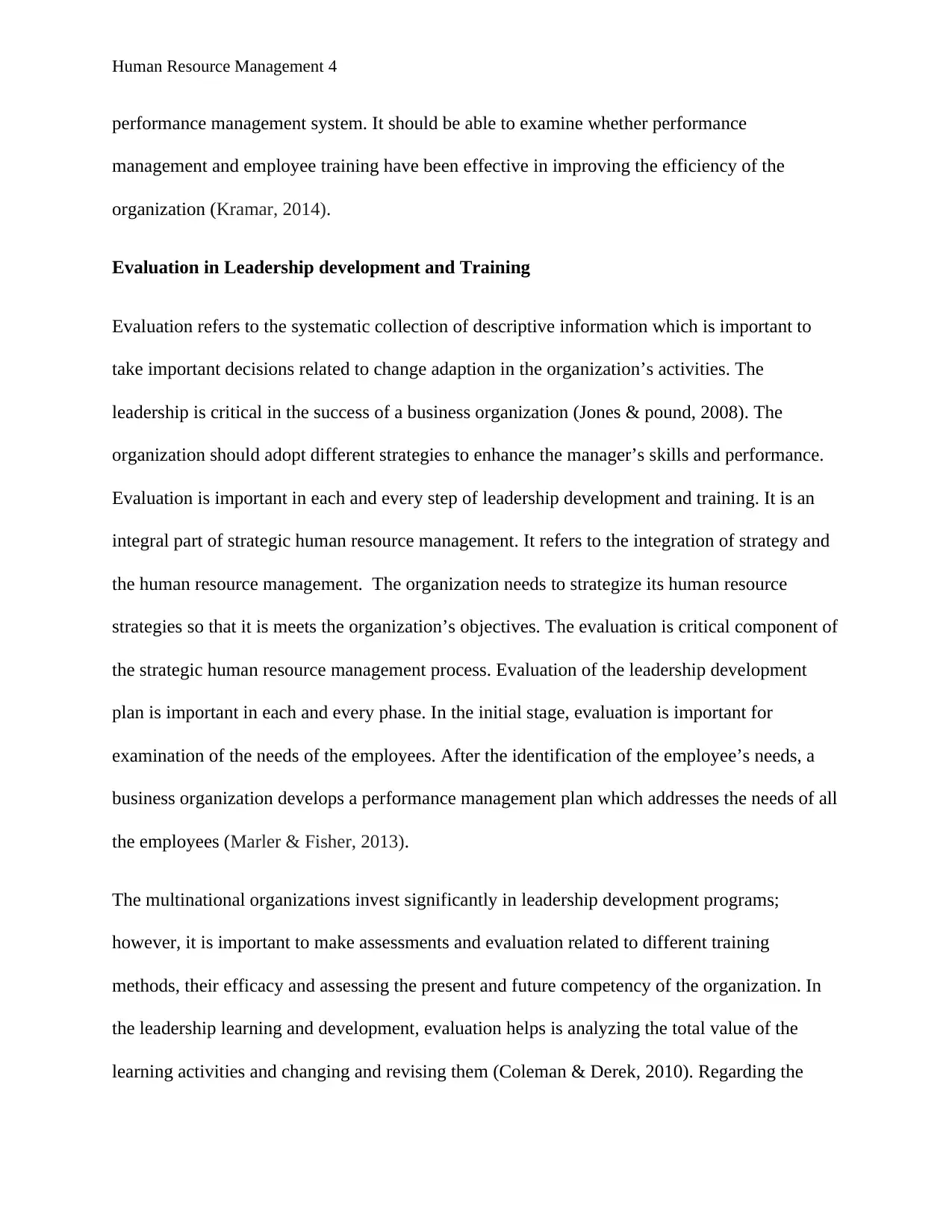
Human Resource Management 4
performance management system. It should be able to examine whether performance
management and employee training have been effective in improving the efficiency of the
organization (Kramar, 2014).
Evaluation in Leadership development and Training
Evaluation refers to the systematic collection of descriptive information which is important to
take important decisions related to change adaption in the organization’s activities. The
leadership is critical in the success of a business organization (Jones & pound, 2008). The
organization should adopt different strategies to enhance the manager’s skills and performance.
Evaluation is important in each and every step of leadership development and training. It is an
integral part of strategic human resource management. It refers to the integration of strategy and
the human resource management. The organization needs to strategize its human resource
strategies so that it is meets the organization’s objectives. The evaluation is critical component of
the strategic human resource management process. Evaluation of the leadership development
plan is important in each and every phase. In the initial stage, evaluation is important for
examination of the needs of the employees. After the identification of the employee’s needs, a
business organization develops a performance management plan which addresses the needs of all
the employees (Marler & Fisher, 2013).
The multinational organizations invest significantly in leadership development programs;
however, it is important to make assessments and evaluation related to different training
methods, their efficacy and assessing the present and future competency of the organization. In
the leadership learning and development, evaluation helps is analyzing the total value of the
learning activities and changing and revising them (Coleman & Derek, 2010). Regarding the
performance management system. It should be able to examine whether performance
management and employee training have been effective in improving the efficiency of the
organization (Kramar, 2014).
Evaluation in Leadership development and Training
Evaluation refers to the systematic collection of descriptive information which is important to
take important decisions related to change adaption in the organization’s activities. The
leadership is critical in the success of a business organization (Jones & pound, 2008). The
organization should adopt different strategies to enhance the manager’s skills and performance.
Evaluation is important in each and every step of leadership development and training. It is an
integral part of strategic human resource management. It refers to the integration of strategy and
the human resource management. The organization needs to strategize its human resource
strategies so that it is meets the organization’s objectives. The evaluation is critical component of
the strategic human resource management process. Evaluation of the leadership development
plan is important in each and every phase. In the initial stage, evaluation is important for
examination of the needs of the employees. After the identification of the employee’s needs, a
business organization develops a performance management plan which addresses the needs of all
the employees (Marler & Fisher, 2013).
The multinational organizations invest significantly in leadership development programs;
however, it is important to make assessments and evaluation related to different training
methods, their efficacy and assessing the present and future competency of the organization. In
the leadership learning and development, evaluation helps is analyzing the total value of the
learning activities and changing and revising them (Coleman & Derek, 2010). Regarding the
Paraphrase This Document
Need a fresh take? Get an instant paraphrase of this document with our AI Paraphraser
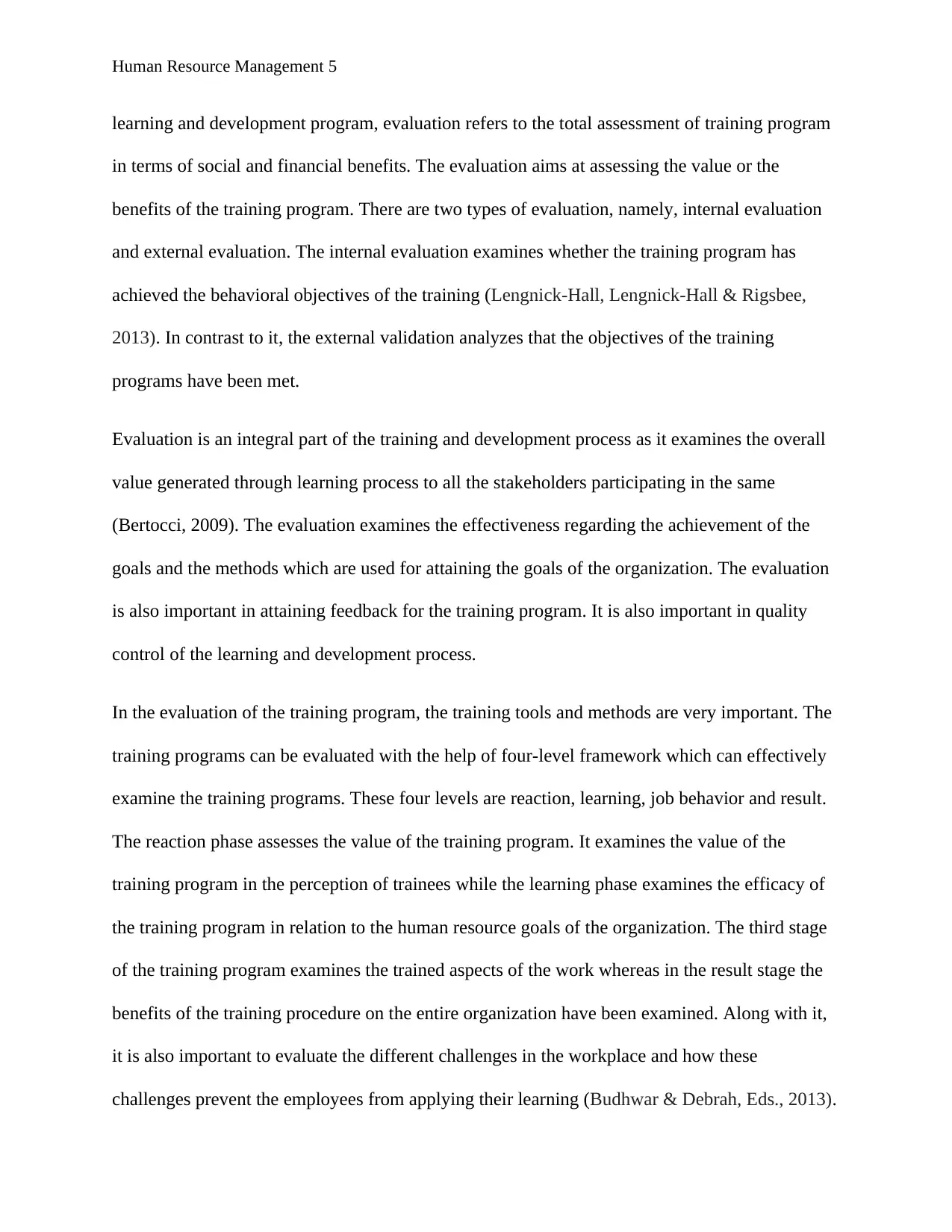
Human Resource Management 5
learning and development program, evaluation refers to the total assessment of training program
in terms of social and financial benefits. The evaluation aims at assessing the value or the
benefits of the training program. There are two types of evaluation, namely, internal evaluation
and external evaluation. The internal evaluation examines whether the training program has
achieved the behavioral objectives of the training (Lengnick-Hall, Lengnick-Hall & Rigsbee,
2013). In contrast to it, the external validation analyzes that the objectives of the training
programs have been met.
Evaluation is an integral part of the training and development process as it examines the overall
value generated through learning process to all the stakeholders participating in the same
(Bertocci, 2009). The evaluation examines the effectiveness regarding the achievement of the
goals and the methods which are used for attaining the goals of the organization. The evaluation
is also important in attaining feedback for the training program. It is also important in quality
control of the learning and development process.
In the evaluation of the training program, the training tools and methods are very important. The
training programs can be evaluated with the help of four-level framework which can effectively
examine the training programs. These four levels are reaction, learning, job behavior and result.
The reaction phase assesses the value of the training program. It examines the value of the
training program in the perception of trainees while the learning phase examines the efficacy of
the training program in relation to the human resource goals of the organization. The third stage
of the training program examines the trained aspects of the work whereas in the result stage the
benefits of the training procedure on the entire organization have been examined. Along with it,
it is also important to evaluate the different challenges in the workplace and how these
challenges prevent the employees from applying their learning (Budhwar & Debrah, Eds., 2013).
learning and development program, evaluation refers to the total assessment of training program
in terms of social and financial benefits. The evaluation aims at assessing the value or the
benefits of the training program. There are two types of evaluation, namely, internal evaluation
and external evaluation. The internal evaluation examines whether the training program has
achieved the behavioral objectives of the training (Lengnick-Hall, Lengnick-Hall & Rigsbee,
2013). In contrast to it, the external validation analyzes that the objectives of the training
programs have been met.
Evaluation is an integral part of the training and development process as it examines the overall
value generated through learning process to all the stakeholders participating in the same
(Bertocci, 2009). The evaluation examines the effectiveness regarding the achievement of the
goals and the methods which are used for attaining the goals of the organization. The evaluation
is also important in attaining feedback for the training program. It is also important in quality
control of the learning and development process.
In the evaluation of the training program, the training tools and methods are very important. The
training programs can be evaluated with the help of four-level framework which can effectively
examine the training programs. These four levels are reaction, learning, job behavior and result.
The reaction phase assesses the value of the training program. It examines the value of the
training program in the perception of trainees while the learning phase examines the efficacy of
the training program in relation to the human resource goals of the organization. The third stage
of the training program examines the trained aspects of the work whereas in the result stage the
benefits of the training procedure on the entire organization have been examined. Along with it,
it is also important to evaluate the different challenges in the workplace and how these
challenges prevent the employees from applying their learning (Budhwar & Debrah, Eds., 2013).
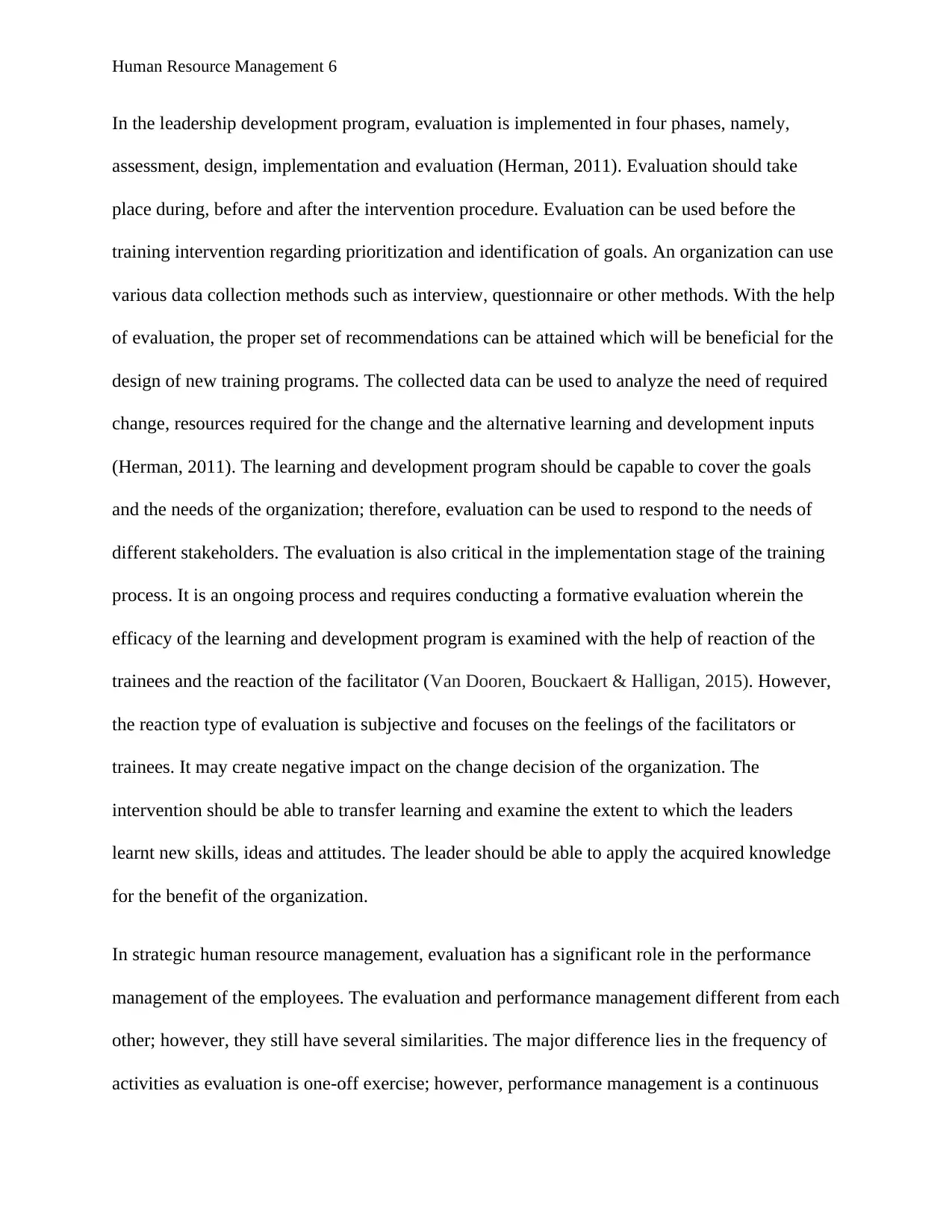
Human Resource Management 6
In the leadership development program, evaluation is implemented in four phases, namely,
assessment, design, implementation and evaluation (Herman, 2011). Evaluation should take
place during, before and after the intervention procedure. Evaluation can be used before the
training intervention regarding prioritization and identification of goals. An organization can use
various data collection methods such as interview, questionnaire or other methods. With the help
of evaluation, the proper set of recommendations can be attained which will be beneficial for the
design of new training programs. The collected data can be used to analyze the need of required
change, resources required for the change and the alternative learning and development inputs
(Herman, 2011). The learning and development program should be capable to cover the goals
and the needs of the organization; therefore, evaluation can be used to respond to the needs of
different stakeholders. The evaluation is also critical in the implementation stage of the training
process. It is an ongoing process and requires conducting a formative evaluation wherein the
efficacy of the learning and development program is examined with the help of reaction of the
trainees and the reaction of the facilitator (Van Dooren, Bouckaert & Halligan, 2015). However,
the reaction type of evaluation is subjective and focuses on the feelings of the facilitators or
trainees. It may create negative impact on the change decision of the organization. The
intervention should be able to transfer learning and examine the extent to which the leaders
learnt new skills, ideas and attitudes. The leader should be able to apply the acquired knowledge
for the benefit of the organization.
In strategic human resource management, evaluation has a significant role in the performance
management of the employees. The evaluation and performance management different from each
other; however, they still have several similarities. The major difference lies in the frequency of
activities as evaluation is one-off exercise; however, performance management is a continuous
In the leadership development program, evaluation is implemented in four phases, namely,
assessment, design, implementation and evaluation (Herman, 2011). Evaluation should take
place during, before and after the intervention procedure. Evaluation can be used before the
training intervention regarding prioritization and identification of goals. An organization can use
various data collection methods such as interview, questionnaire or other methods. With the help
of evaluation, the proper set of recommendations can be attained which will be beneficial for the
design of new training programs. The collected data can be used to analyze the need of required
change, resources required for the change and the alternative learning and development inputs
(Herman, 2011). The learning and development program should be capable to cover the goals
and the needs of the organization; therefore, evaluation can be used to respond to the needs of
different stakeholders. The evaluation is also critical in the implementation stage of the training
process. It is an ongoing process and requires conducting a formative evaluation wherein the
efficacy of the learning and development program is examined with the help of reaction of the
trainees and the reaction of the facilitator (Van Dooren, Bouckaert & Halligan, 2015). However,
the reaction type of evaluation is subjective and focuses on the feelings of the facilitators or
trainees. It may create negative impact on the change decision of the organization. The
intervention should be able to transfer learning and examine the extent to which the leaders
learnt new skills, ideas and attitudes. The leader should be able to apply the acquired knowledge
for the benefit of the organization.
In strategic human resource management, evaluation has a significant role in the performance
management of the employees. The evaluation and performance management different from each
other; however, they still have several similarities. The major difference lies in the frequency of
activities as evaluation is one-off exercise; however, performance management is a continuous
⊘ This is a preview!⊘
Do you want full access?
Subscribe today to unlock all pages.

Trusted by 1+ million students worldwide
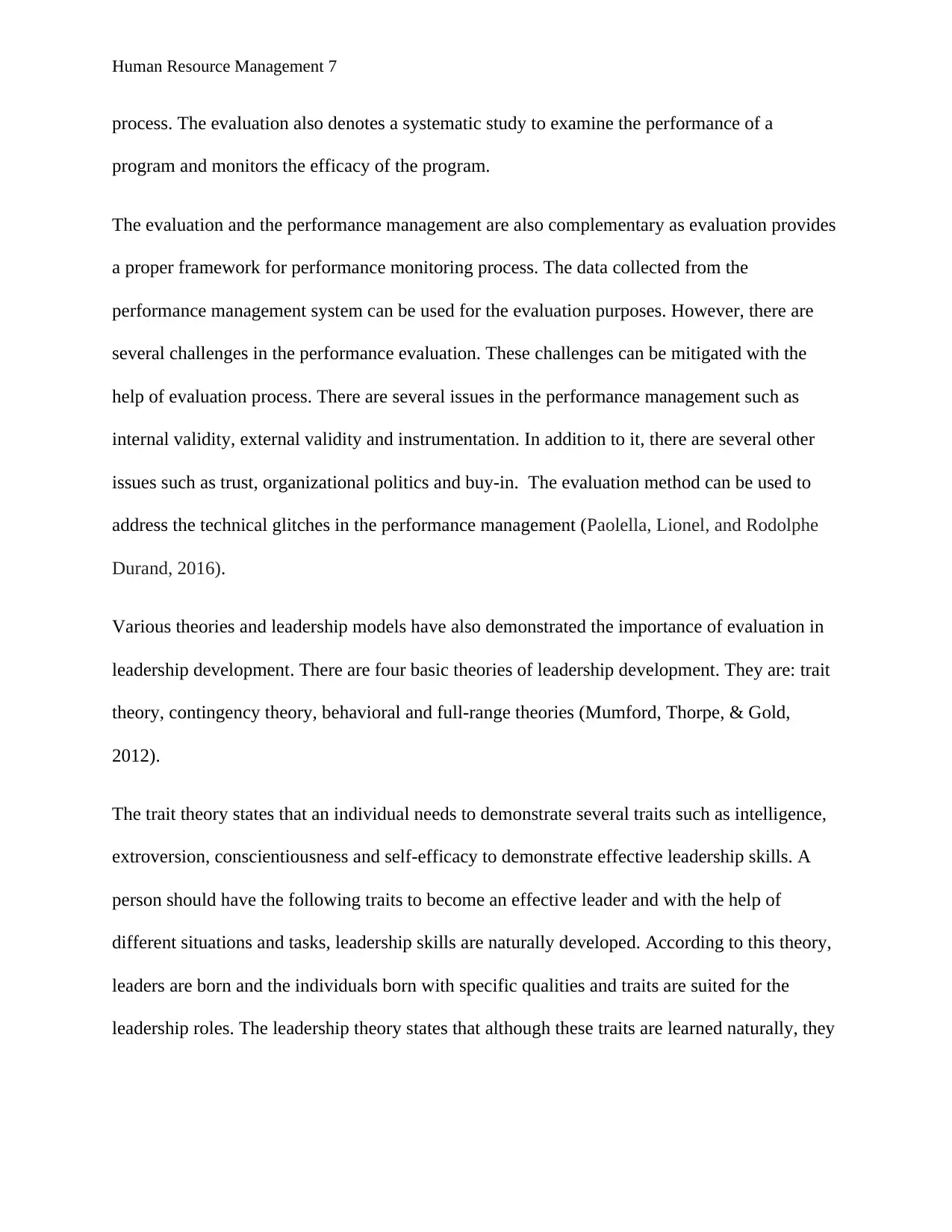
Human Resource Management 7
process. The evaluation also denotes a systematic study to examine the performance of a
program and monitors the efficacy of the program.
The evaluation and the performance management are also complementary as evaluation provides
a proper framework for performance monitoring process. The data collected from the
performance management system can be used for the evaluation purposes. However, there are
several challenges in the performance evaluation. These challenges can be mitigated with the
help of evaluation process. There are several issues in the performance management such as
internal validity, external validity and instrumentation. In addition to it, there are several other
issues such as trust, organizational politics and buy-in. The evaluation method can be used to
address the technical glitches in the performance management (Paolella, Lionel, and Rodolphe
Durand, 2016).
Various theories and leadership models have also demonstrated the importance of evaluation in
leadership development. There are four basic theories of leadership development. They are: trait
theory, contingency theory, behavioral and full-range theories (Mumford, Thorpe, & Gold,
2012).
The trait theory states that an individual needs to demonstrate several traits such as intelligence,
extroversion, conscientiousness and self-efficacy to demonstrate effective leadership skills. A
person should have the following traits to become an effective leader and with the help of
different situations and tasks, leadership skills are naturally developed. According to this theory,
leaders are born and the individuals born with specific qualities and traits are suited for the
leadership roles. The leadership theory states that although these traits are learned naturally, they
process. The evaluation also denotes a systematic study to examine the performance of a
program and monitors the efficacy of the program.
The evaluation and the performance management are also complementary as evaluation provides
a proper framework for performance monitoring process. The data collected from the
performance management system can be used for the evaluation purposes. However, there are
several challenges in the performance evaluation. These challenges can be mitigated with the
help of evaluation process. There are several issues in the performance management such as
internal validity, external validity and instrumentation. In addition to it, there are several other
issues such as trust, organizational politics and buy-in. The evaluation method can be used to
address the technical glitches in the performance management (Paolella, Lionel, and Rodolphe
Durand, 2016).
Various theories and leadership models have also demonstrated the importance of evaluation in
leadership development. There are four basic theories of leadership development. They are: trait
theory, contingency theory, behavioral and full-range theories (Mumford, Thorpe, & Gold,
2012).
The trait theory states that an individual needs to demonstrate several traits such as intelligence,
extroversion, conscientiousness and self-efficacy to demonstrate effective leadership skills. A
person should have the following traits to become an effective leader and with the help of
different situations and tasks, leadership skills are naturally developed. According to this theory,
leaders are born and the individuals born with specific qualities and traits are suited for the
leadership roles. The leadership theory states that although these traits are learned naturally, they
Paraphrase This Document
Need a fresh take? Get an instant paraphrase of this document with our AI Paraphraser
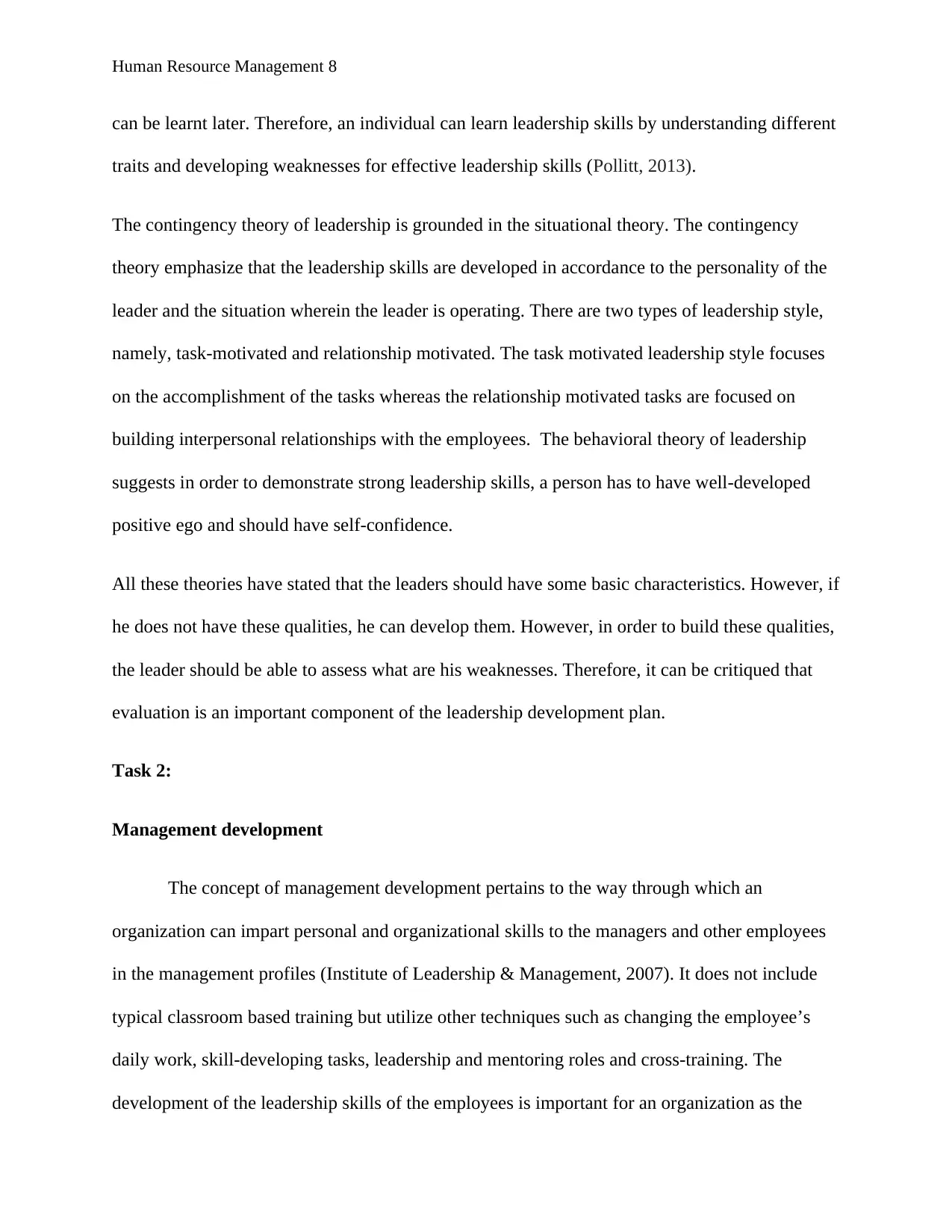
Human Resource Management 8
can be learnt later. Therefore, an individual can learn leadership skills by understanding different
traits and developing weaknesses for effective leadership skills (Pollitt, 2013).
The contingency theory of leadership is grounded in the situational theory. The contingency
theory emphasize that the leadership skills are developed in accordance to the personality of the
leader and the situation wherein the leader is operating. There are two types of leadership style,
namely, task-motivated and relationship motivated. The task motivated leadership style focuses
on the accomplishment of the tasks whereas the relationship motivated tasks are focused on
building interpersonal relationships with the employees. The behavioral theory of leadership
suggests in order to demonstrate strong leadership skills, a person has to have well-developed
positive ego and should have self-confidence.
All these theories have stated that the leaders should have some basic characteristics. However, if
he does not have these qualities, he can develop them. However, in order to build these qualities,
the leader should be able to assess what are his weaknesses. Therefore, it can be critiqued that
evaluation is an important component of the leadership development plan.
Task 2:
Management development
The concept of management development pertains to the way through which an
organization can impart personal and organizational skills to the managers and other employees
in the management profiles (Institute of Leadership & Management, 2007). It does not include
typical classroom based training but utilize other techniques such as changing the employee’s
daily work, skill-developing tasks, leadership and mentoring roles and cross-training. The
development of the leadership skills of the employees is important for an organization as the
can be learnt later. Therefore, an individual can learn leadership skills by understanding different
traits and developing weaknesses for effective leadership skills (Pollitt, 2013).
The contingency theory of leadership is grounded in the situational theory. The contingency
theory emphasize that the leadership skills are developed in accordance to the personality of the
leader and the situation wherein the leader is operating. There are two types of leadership style,
namely, task-motivated and relationship motivated. The task motivated leadership style focuses
on the accomplishment of the tasks whereas the relationship motivated tasks are focused on
building interpersonal relationships with the employees. The behavioral theory of leadership
suggests in order to demonstrate strong leadership skills, a person has to have well-developed
positive ego and should have self-confidence.
All these theories have stated that the leaders should have some basic characteristics. However, if
he does not have these qualities, he can develop them. However, in order to build these qualities,
the leader should be able to assess what are his weaknesses. Therefore, it can be critiqued that
evaluation is an important component of the leadership development plan.
Task 2:
Management development
The concept of management development pertains to the way through which an
organization can impart personal and organizational skills to the managers and other employees
in the management profiles (Institute of Leadership & Management, 2007). It does not include
typical classroom based training but utilize other techniques such as changing the employee’s
daily work, skill-developing tasks, leadership and mentoring roles and cross-training. The
development of the leadership skills of the employees is important for an organization as the
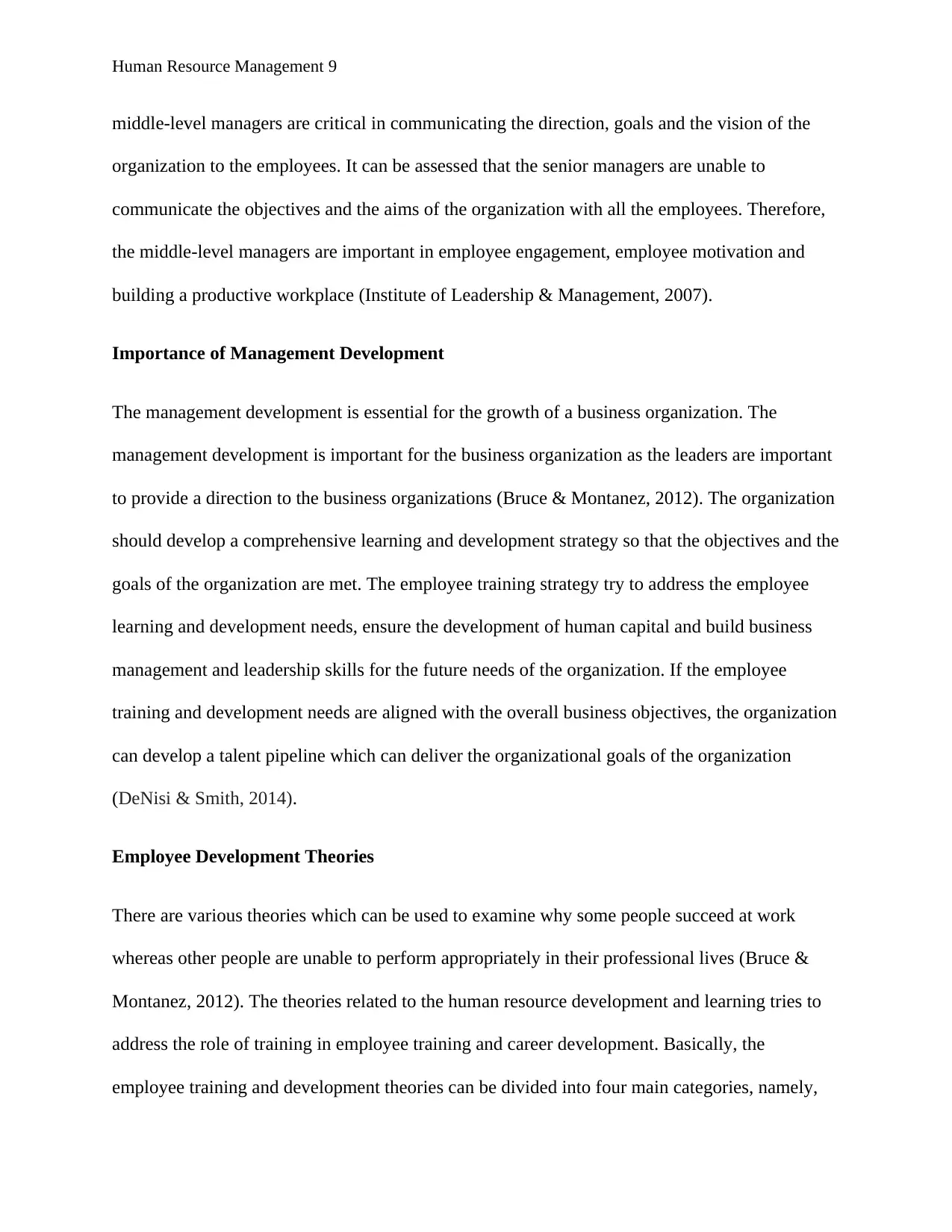
Human Resource Management 9
middle-level managers are critical in communicating the direction, goals and the vision of the
organization to the employees. It can be assessed that the senior managers are unable to
communicate the objectives and the aims of the organization with all the employees. Therefore,
the middle-level managers are important in employee engagement, employee motivation and
building a productive workplace (Institute of Leadership & Management, 2007).
Importance of Management Development
The management development is essential for the growth of a business organization. The
management development is important for the business organization as the leaders are important
to provide a direction to the business organizations (Bruce & Montanez, 2012). The organization
should develop a comprehensive learning and development strategy so that the objectives and the
goals of the organization are met. The employee training strategy try to address the employee
learning and development needs, ensure the development of human capital and build business
management and leadership skills for the future needs of the organization. If the employee
training and development needs are aligned with the overall business objectives, the organization
can develop a talent pipeline which can deliver the organizational goals of the organization
(DeNisi & Smith, 2014).
Employee Development Theories
There are various theories which can be used to examine why some people succeed at work
whereas other people are unable to perform appropriately in their professional lives (Bruce &
Montanez, 2012). The theories related to the human resource development and learning tries to
address the role of training in employee training and career development. Basically, the
employee training and development theories can be divided into four main categories, namely,
middle-level managers are critical in communicating the direction, goals and the vision of the
organization to the employees. It can be assessed that the senior managers are unable to
communicate the objectives and the aims of the organization with all the employees. Therefore,
the middle-level managers are important in employee engagement, employee motivation and
building a productive workplace (Institute of Leadership & Management, 2007).
Importance of Management Development
The management development is essential for the growth of a business organization. The
management development is important for the business organization as the leaders are important
to provide a direction to the business organizations (Bruce & Montanez, 2012). The organization
should develop a comprehensive learning and development strategy so that the objectives and the
goals of the organization are met. The employee training strategy try to address the employee
learning and development needs, ensure the development of human capital and build business
management and leadership skills for the future needs of the organization. If the employee
training and development needs are aligned with the overall business objectives, the organization
can develop a talent pipeline which can deliver the organizational goals of the organization
(DeNisi & Smith, 2014).
Employee Development Theories
There are various theories which can be used to examine why some people succeed at work
whereas other people are unable to perform appropriately in their professional lives (Bruce &
Montanez, 2012). The theories related to the human resource development and learning tries to
address the role of training in employee training and career development. Basically, the
employee training and development theories can be divided into four main categories, namely,
⊘ This is a preview!⊘
Do you want full access?
Subscribe today to unlock all pages.

Trusted by 1+ million students worldwide
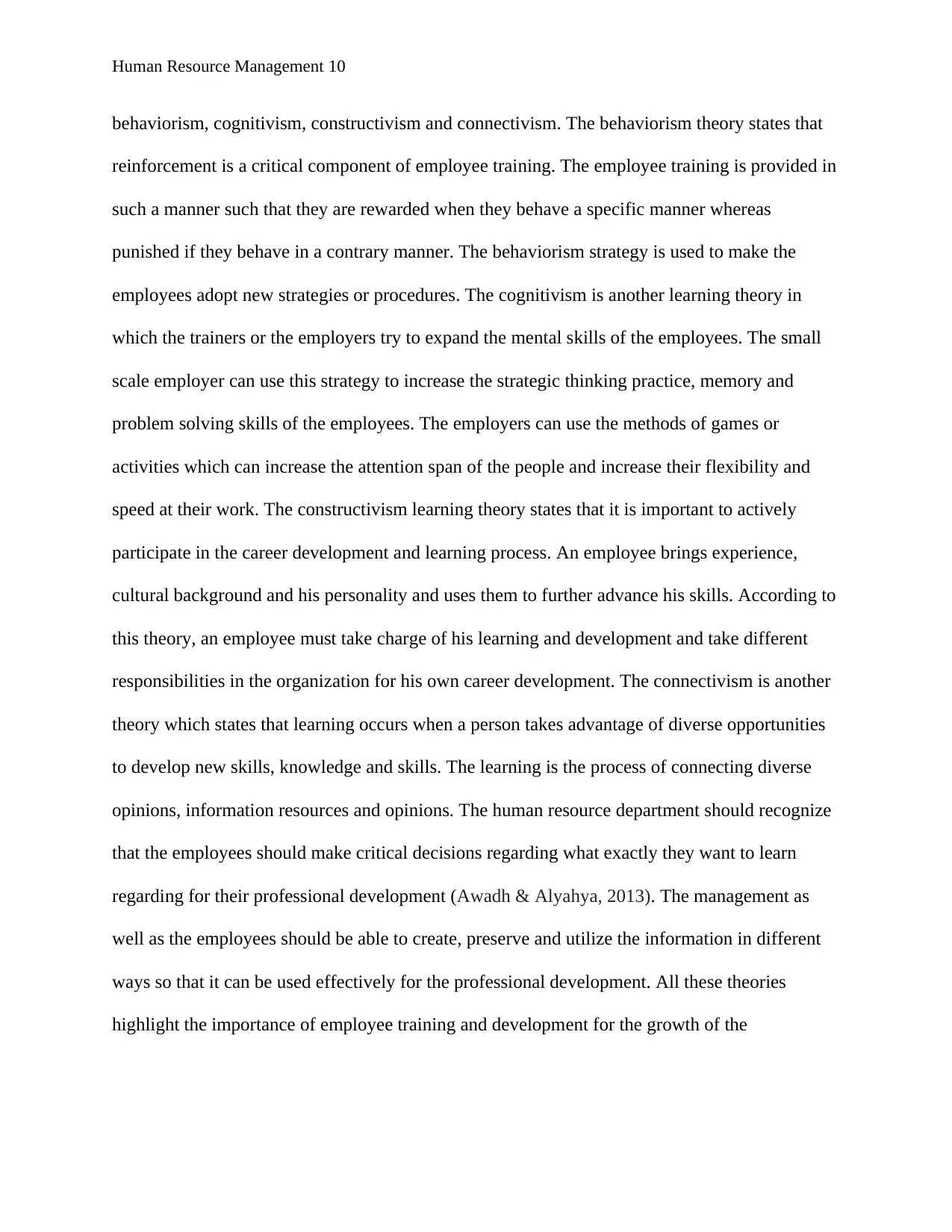
Human Resource Management 10
behaviorism, cognitivism, constructivism and connectivism. The behaviorism theory states that
reinforcement is a critical component of employee training. The employee training is provided in
such a manner such that they are rewarded when they behave a specific manner whereas
punished if they behave in a contrary manner. The behaviorism strategy is used to make the
employees adopt new strategies or procedures. The cognitivism is another learning theory in
which the trainers or the employers try to expand the mental skills of the employees. The small
scale employer can use this strategy to increase the strategic thinking practice, memory and
problem solving skills of the employees. The employers can use the methods of games or
activities which can increase the attention span of the people and increase their flexibility and
speed at their work. The constructivism learning theory states that it is important to actively
participate in the career development and learning process. An employee brings experience,
cultural background and his personality and uses them to further advance his skills. According to
this theory, an employee must take charge of his learning and development and take different
responsibilities in the organization for his own career development. The connectivism is another
theory which states that learning occurs when a person takes advantage of diverse opportunities
to develop new skills, knowledge and skills. The learning is the process of connecting diverse
opinions, information resources and opinions. The human resource department should recognize
that the employees should make critical decisions regarding what exactly they want to learn
regarding for their professional development (Awadh & Alyahya, 2013). The management as
well as the employees should be able to create, preserve and utilize the information in different
ways so that it can be used effectively for the professional development. All these theories
highlight the importance of employee training and development for the growth of the
behaviorism, cognitivism, constructivism and connectivism. The behaviorism theory states that
reinforcement is a critical component of employee training. The employee training is provided in
such a manner such that they are rewarded when they behave a specific manner whereas
punished if they behave in a contrary manner. The behaviorism strategy is used to make the
employees adopt new strategies or procedures. The cognitivism is another learning theory in
which the trainers or the employers try to expand the mental skills of the employees. The small
scale employer can use this strategy to increase the strategic thinking practice, memory and
problem solving skills of the employees. The employers can use the methods of games or
activities which can increase the attention span of the people and increase their flexibility and
speed at their work. The constructivism learning theory states that it is important to actively
participate in the career development and learning process. An employee brings experience,
cultural background and his personality and uses them to further advance his skills. According to
this theory, an employee must take charge of his learning and development and take different
responsibilities in the organization for his own career development. The connectivism is another
theory which states that learning occurs when a person takes advantage of diverse opportunities
to develop new skills, knowledge and skills. The learning is the process of connecting diverse
opinions, information resources and opinions. The human resource department should recognize
that the employees should make critical decisions regarding what exactly they want to learn
regarding for their professional development (Awadh & Alyahya, 2013). The management as
well as the employees should be able to create, preserve and utilize the information in different
ways so that it can be used effectively for the professional development. All these theories
highlight the importance of employee training and development for the growth of the
Paraphrase This Document
Need a fresh take? Get an instant paraphrase of this document with our AI Paraphraser
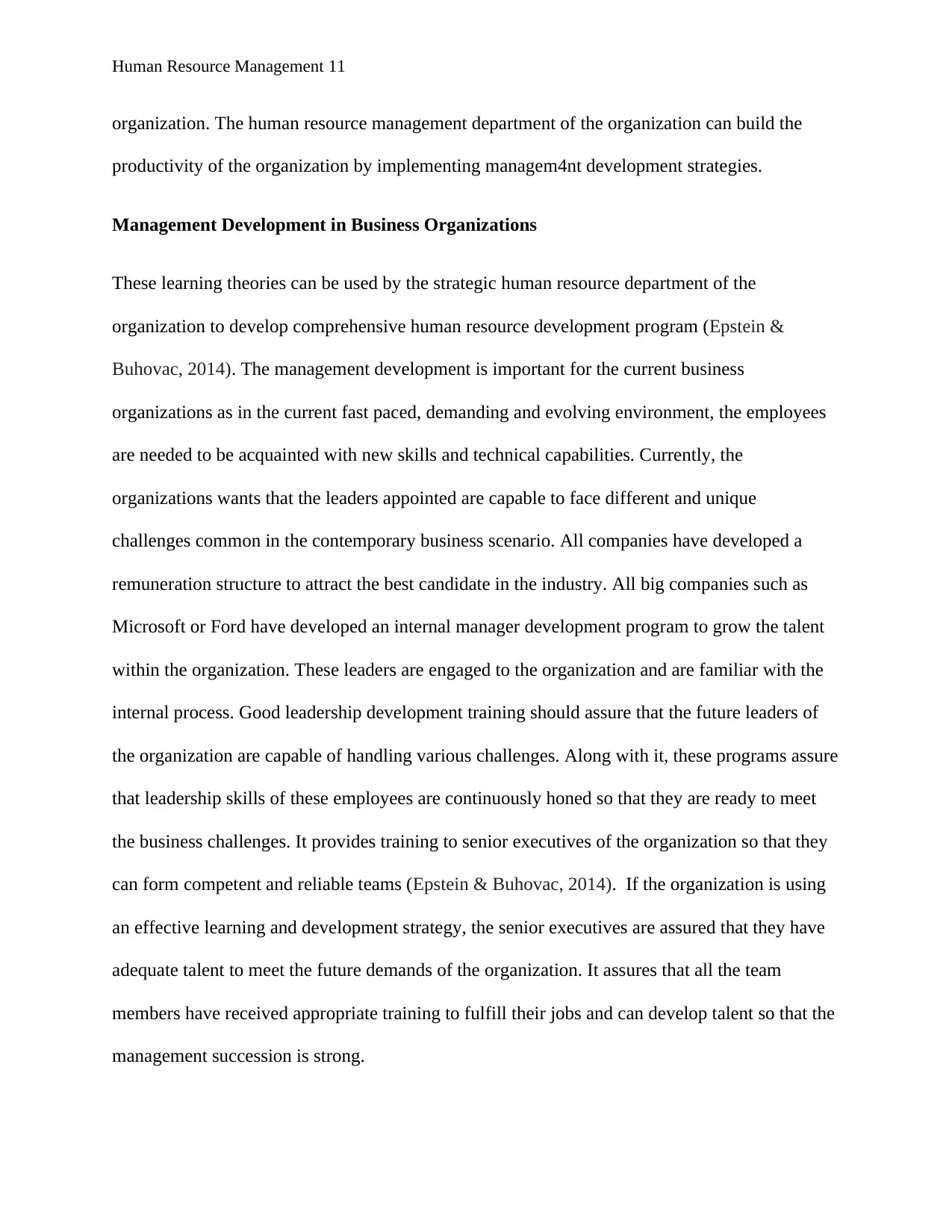
Human Resource Management 11
organization. The human resource management department of the organization can build the
productivity of the organization by implementing managem4nt development strategies.
Management Development in Business Organizations
These learning theories can be used by the strategic human resource department of the
organization to develop comprehensive human resource development program (Epstein &
Buhovac, 2014). The management development is important for the current business
organizations as in the current fast paced, demanding and evolving environment, the employees
are needed to be acquainted with new skills and technical capabilities. Currently, the
organizations wants that the leaders appointed are capable to face different and unique
challenges common in the contemporary business scenario. All companies have developed a
remuneration structure to attract the best candidate in the industry. All big companies such as
Microsoft or Ford have developed an internal manager development program to grow the talent
within the organization. These leaders are engaged to the organization and are familiar with the
internal process. Good leadership development training should assure that the future leaders of
the organization are capable of handling various challenges. Along with it, these programs assure
that leadership skills of these employees are continuously honed so that they are ready to meet
the business challenges. It provides training to senior executives of the organization so that they
can form competent and reliable teams (Epstein & Buhovac, 2014). If the organization is using
an effective learning and development strategy, the senior executives are assured that they have
adequate talent to meet the future demands of the organization. It assures that all the team
members have received appropriate training to fulfill their jobs and can develop talent so that the
management succession is strong.
organization. The human resource management department of the organization can build the
productivity of the organization by implementing managem4nt development strategies.
Management Development in Business Organizations
These learning theories can be used by the strategic human resource department of the
organization to develop comprehensive human resource development program (Epstein &
Buhovac, 2014). The management development is important for the current business
organizations as in the current fast paced, demanding and evolving environment, the employees
are needed to be acquainted with new skills and technical capabilities. Currently, the
organizations wants that the leaders appointed are capable to face different and unique
challenges common in the contemporary business scenario. All companies have developed a
remuneration structure to attract the best candidate in the industry. All big companies such as
Microsoft or Ford have developed an internal manager development program to grow the talent
within the organization. These leaders are engaged to the organization and are familiar with the
internal process. Good leadership development training should assure that the future leaders of
the organization are capable of handling various challenges. Along with it, these programs assure
that leadership skills of these employees are continuously honed so that they are ready to meet
the business challenges. It provides training to senior executives of the organization so that they
can form competent and reliable teams (Epstein & Buhovac, 2014). If the organization is using
an effective learning and development strategy, the senior executives are assured that they have
adequate talent to meet the future demands of the organization. It assures that all the team
members have received appropriate training to fulfill their jobs and can develop talent so that the
management succession is strong.
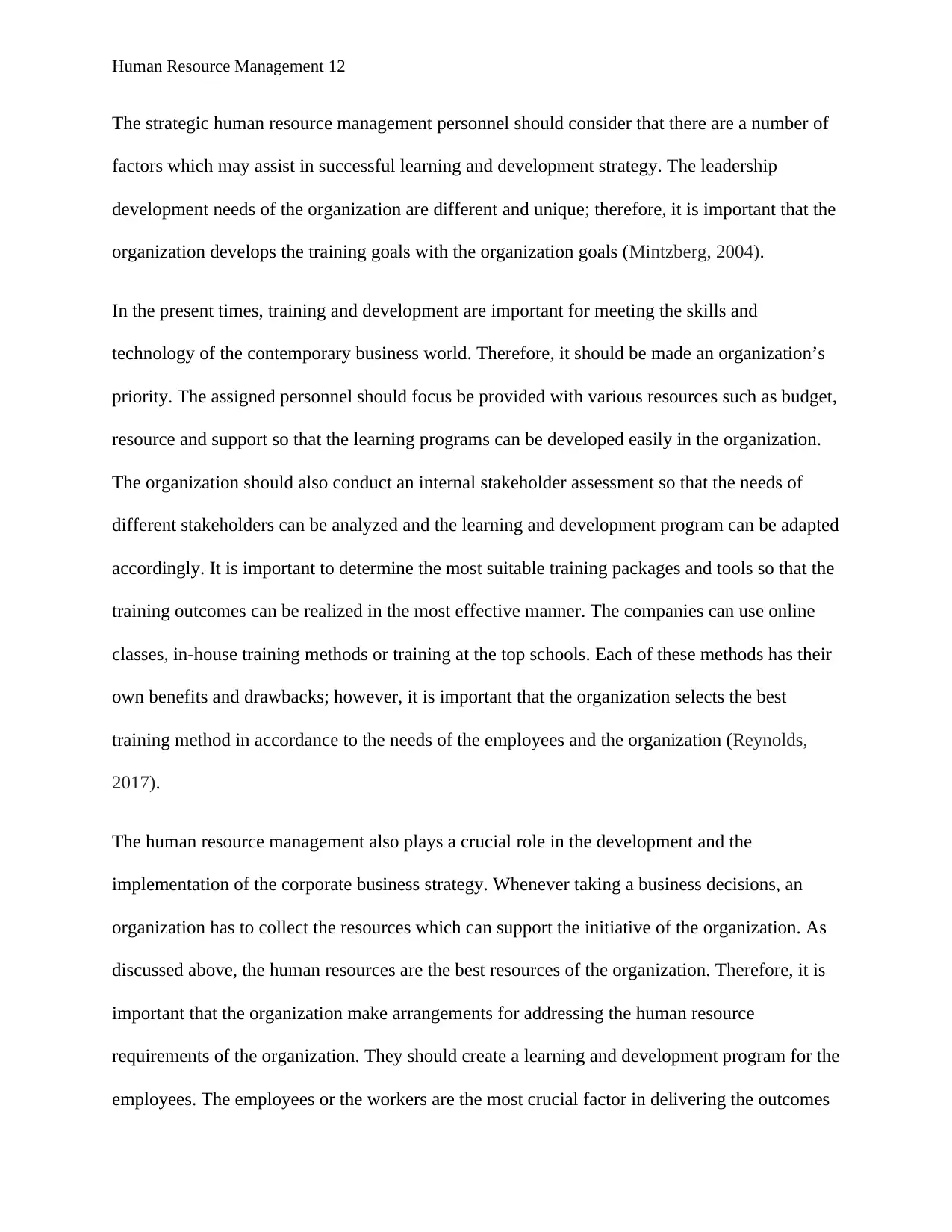
Human Resource Management 12
The strategic human resource management personnel should consider that there are a number of
factors which may assist in successful learning and development strategy. The leadership
development needs of the organization are different and unique; therefore, it is important that the
organization develops the training goals with the organization goals (Mintzberg, 2004).
In the present times, training and development are important for meeting the skills and
technology of the contemporary business world. Therefore, it should be made an organization’s
priority. The assigned personnel should focus be provided with various resources such as budget,
resource and support so that the learning programs can be developed easily in the organization.
The organization should also conduct an internal stakeholder assessment so that the needs of
different stakeholders can be analyzed and the learning and development program can be adapted
accordingly. It is important to determine the most suitable training packages and tools so that the
training outcomes can be realized in the most effective manner. The companies can use online
classes, in-house training methods or training at the top schools. Each of these methods has their
own benefits and drawbacks; however, it is important that the organization selects the best
training method in accordance to the needs of the employees and the organization (Reynolds,
2017).
The human resource management also plays a crucial role in the development and the
implementation of the corporate business strategy. Whenever taking a business decisions, an
organization has to collect the resources which can support the initiative of the organization. As
discussed above, the human resources are the best resources of the organization. Therefore, it is
important that the organization make arrangements for addressing the human resource
requirements of the organization. They should create a learning and development program for the
employees. The employees or the workers are the most crucial factor in delivering the outcomes
The strategic human resource management personnel should consider that there are a number of
factors which may assist in successful learning and development strategy. The leadership
development needs of the organization are different and unique; therefore, it is important that the
organization develops the training goals with the organization goals (Mintzberg, 2004).
In the present times, training and development are important for meeting the skills and
technology of the contemporary business world. Therefore, it should be made an organization’s
priority. The assigned personnel should focus be provided with various resources such as budget,
resource and support so that the learning programs can be developed easily in the organization.
The organization should also conduct an internal stakeholder assessment so that the needs of
different stakeholders can be analyzed and the learning and development program can be adapted
accordingly. It is important to determine the most suitable training packages and tools so that the
training outcomes can be realized in the most effective manner. The companies can use online
classes, in-house training methods or training at the top schools. Each of these methods has their
own benefits and drawbacks; however, it is important that the organization selects the best
training method in accordance to the needs of the employees and the organization (Reynolds,
2017).
The human resource management also plays a crucial role in the development and the
implementation of the corporate business strategy. Whenever taking a business decisions, an
organization has to collect the resources which can support the initiative of the organization. As
discussed above, the human resources are the best resources of the organization. Therefore, it is
important that the organization make arrangements for addressing the human resource
requirements of the organization. They should create a learning and development program for the
employees. The employees or the workers are the most crucial factor in delivering the outcomes
⊘ This is a preview!⊘
Do you want full access?
Subscribe today to unlock all pages.

Trusted by 1+ million students worldwide
1 out of 17
Related Documents
Your All-in-One AI-Powered Toolkit for Academic Success.
+13062052269
info@desklib.com
Available 24*7 on WhatsApp / Email
![[object Object]](/_next/static/media/star-bottom.7253800d.svg)
Unlock your academic potential
Copyright © 2020–2025 A2Z Services. All Rights Reserved. Developed and managed by ZUCOL.



